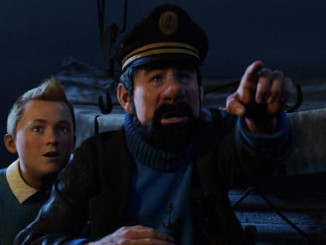 “No one cry when Jaws die. But when the monkey die, people gonna cry.”
“No one cry when Jaws die. But when the monkey die, people gonna cry.”
So stated producer Dino De Laurentiis in an October 1976 issue of Time Magazine prior to the release of his remake of the classic 1933 monster film King Kong. While De Laurentiis was a master of hype, his film fell short of being the tear-jerker he promised. While director Peter Jackson has not made any such grandiose claims about his own remake of King Kong, he very well could, as his version of this now thrice told tale not only surpasses the action quota of the original but its emotional depth as well.
The film opens with a montage comprised of reenactments of several famous 1933 Depression-era photographs of New York City, set to Al Jolson’s “Sitting On Top Of The World”. Unlike the 1976 version, Jackson has wisely kept his film set in the same time that the original was made, when satellite mapping hadn’t shrunk the world enough to eliminate wonder of the possibility of lost civilizations and undiscovered islands. It was a time when people found the American Dream far from reach, no matter how hard and desperately they grasped for it. No one grasped harder for his share of success and fame than Carl Denham (Jack Black), a filmmaker whose drive and ambition far outweigh his abilities. Faced with the fact that the studio executives want to pull the plug on his latest film mid-way through production, Denham flees New York City with his crew – which include kidnapped screenwriter Jack Driscoll (Adrian Brody) and hesitant leading lady Ann Darrow (Naomi Watts) – for a mysterious island and a rendezvous with a gorilla larger than anyone believed imaginable.
Jackson has often stated his fondness for the original Kong, often citing it as the film that first inspired him to become a filmmaker. That love can be seen in every frame of the film, from the incredibly detailed recreation of New York City to the dense, monster-laden Skull Island. There are also several sly nods to the original film for folks to find. While Jackson has remained faithful to the original’s storyline, the action set pieces are staged with an energy and a scale that the original’s special effects mastermind Willis O’Brien would probably never have imagined possible. Much like his work in The Lord Of The Rings, Jackson imparts a sense of history to the fantastic elements of the story- jungle-covered ruins hint at a civilization that once flourished on Skull Island while Kong himself carries the scars of a lifetime filled with battles of survival.
 If there are any inherent flaws in the original film’s story, it is that after the slam-bang adventure of Skull Island and Kong’s rampage through New York, his final fate at the top of the Empire State Building seems almost anti-climactic. However, because the script works hard to establish the bond between Ann and Kong, the scene has sudden emotional resonance to it, giving it a greater sense of impending doom and tragedy than in the original.
If there are any inherent flaws in the original film’s story, it is that after the slam-bang adventure of Skull Island and Kong’s rampage through New York, his final fate at the top of the Empire State Building seems almost anti-climactic. However, because the script works hard to establish the bond between Ann and Kong, the scene has sudden emotional resonance to it, giving it a greater sense of impending doom and tragedy than in the original.
Naomi Watts deserves special mention here for her extraordinary work through the middle-third of the film. Acting against the blank spot where Kong would be digitally added, Watts shoulders the responsibility of realizing the relationship between Ann and Kong and delivers a remarkable performance that had the danger of becoming laughable with the slightest misstep.
Sure there are a few small things that one could nitpick. Jackson spends time in trying to keep the various crew members who will meet grisly ends on Skull Island from being just faceless, nameless victims that could have been better used developing the relationship between Jack and Ann. This is especially apparent when the sailors that do survive their harrowing ordeal are totally absent from the film’s New York City-set third act, distracting the viewer with their disappearance.




